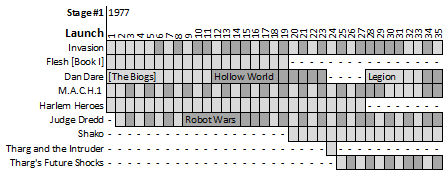Stage 01 - Launch
Progs 1-35: 1977
 |
 |
 |
| Prog 19 by Brian Bolland | Prog 23 by Brian Bolland | Prog 27 by Brian Bolland |

Invasion
Cockney rebel Bill Savage defends Britain from invading Russians Volgans.
Continues in the next stage...
Flesh [Book I]
Cowboys from the future harvest dinosaurs from the past: what could possibly go wrong?
A second series turns up in prog 86...
Dan Dare
It's like Star Trek, except they kill all the aliens.
Continues in the next stage...
M.A.C.H.1
The Six Million Dollar Man crossed with James Bond.
Continues in the next stage...
Harlem Heroes
Basketball meets Rollerball (minus motorbikes, plus jetpacks).
Returns in the next stage as the sequel series Inferno...
Judge Dredd
Dirty Harry filtered through Death Race 2000.
Continues in all subsequent stages...
Shako
If Jaws were a polar bear...
This is the only series of Shako, although he cameos in future thrills.
Tharg and the Intruder
Alien editor deals with various assaults on thrill power.
Returns in prog 129...
Tharg's Future Shocks
Usually one-off tales with a twist.
More in the next stage...
Notes:
Looking at this first stage closely, it's notable (especially for modern readers) how different early 2000 AD is from modern. I've color-split the thrills (light grey / dark grey) to show how Barney has them indexed as separate, smaller segments within a larger narrative:

Examining Invasion as a key example, there are 23 separate Barney entries for the first 35 progs (which inside the prog are all just titled as simply "Invasion"). Each tells its own mini-story. These 23 segments have four writers (Pat Mills, Gerry Finley-Day, Nick Allen & Nick Flynn) and eight artists (Jesus Blasco, Pat Wright, Sarompas, Ian Kennedy, Mike Dorey, Carlos Pino, Eric Bradbury & Luis Collado), who are not necessarily split neatly within the storytelling narrative.
You find a similar story with Judge Dredd, Harlem Heroes, Flesh and M.A.C.H.1: multiple artists and writers shoulder the work, and even longer stories within the larger narrative don't get provided a single artist. For example, Robot Wars has four artists split over the 9 parts, and then not even sequentially. Ian Gibson does the work in progs 14 & 17, for example.
This entire first stage is before creator credits (which start in prog 36), and this pragmatic approach to getting thrills out (just use any artist!) was very much the nature of comic creation at the time. The benefits are clear: you get the thrills out on time. The downside is that you lose narrative cohesion and a strong, consistent artistic vision.
Standing out, then, is the heroic Massimo Belardinelli, who provides the first 23 progs of Dan Dare.
As someone who started reading in the early 300s the early progs feel like a completely different world to even '83 2000 AD. The art style is very different and there's a luridly violent, punkish tone to it.
Extras:

Those without the progs might be interested in the wide array of alternative content that graced the early era of 2000 AD and sometimes isn't visible through great resources such as Barney.
Prior to Star Pin-Ups (which start in stage 2), there was diagrammatic content in the form of various strip-related Futuregraphs (like the Harlem Heroes Power Gear in prog 2 and Mega-City 1 map in prog 3).
Progs 8-11 provided a collectible Flesh card game: in which Squaxx were told to cut up their progs to create the game.
...aaand this is why I have no intact early progs. I used to cut out every piece of those bastard fiddly board games, and IF I could ever persuade someone to have a game, it would turn out either to be tediously simple or mind-bendingly complicated.
Progs 19-43 hijacked the cover for Supercover Saga: there'd be an image on the cover relating to a short text story inside (often part of the Nerve Centre).
Progs 26-32 have a (cut and mount) collectible poster series called Futurefocus, which imagines things like a Space Hospital and Star Warriors (which are just Stormtroopers).
